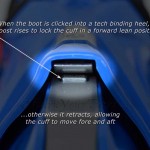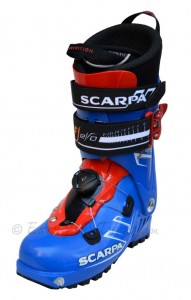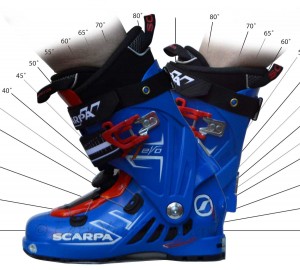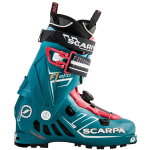BOA Lacing
Three things are exciting about the F1, starting with the use of BOA lacing on the forefoot. This holds your foot snug with micro-adaptability to the shape of the roof of a foot. It also has a huge range of volume adjustment, allowing for adaptability from a low-instep to a moderately high one. The limit to instep height has more to do with the correlation between width and height, so by the time you have a foot with a really high instep, the width is too narrow to even consider this boot.
This is the first use of a BOA system in a ski boot that I’m impressed with. It was used by Black Diamond in the cuff of their ski boots when first introduced, but it didn’t really improve the boots performance. That’s because the BOA system tends to concentrate pressure in the laces closest to the tightening ring. When used on a cuff, the seal at the top of the cuff was solid, but down low, where you wanted and needed a tighter fit, it was hard to maintain adequate pressure. With Scarpa’s use on the lower shell the BOA laces tighten perfectly over your instep, with decreased pressure over the middle of your foot where you want some wiggle room and good blood flow.
It is rated as a 102mm wide last, not as narrow as it looks, so it accommodates the majority of feet, from a B to a D width without modifying the shell. It is a thin shell made with Pebax and a carbon reinforced sole for improved stiffness. With proper heat and pressure Pebax punches easily, but it tends to relax over time.
Buckled Cuff Strap
Anyone who follows this writers perspective knows I’m a fan of buckled velcro straps. From my soft teleboot perspective, I don’t need that much restraint around my cuff and when it’s time to climb, it is too convenient to simply open the buckle and let the cuff loosen without having to reset a wire buckle to a lower tension. And, it won’t come undone and flop around, remaining loose but secure. It’s the little things like this that separate designs. In recognition of that, there are no metal buckles on the cuff of the F1 Evo. Which raises the question of whether you want a pair or not. Perhaps the absence of a metal buckle on the cuff does limit how stiff the cuff will feel and I’ll admit that the F1 Evo gets soft at only medium speeds, suggesting that there is a limit to how well stretchable straps can transfer power from your lower leg. On the otherhand, it may not be the buckled strap, but simply the fact that Scarpa rates the stiffness of the F1-Evo at a mere 95, substantially below the flex index many skiers desire for powerful turns. Forward lean is adjustable to 16°, 18°, or 20°.Automatic Walk Mode

When you’re not locked in to a tech binding, the boot is in walk mode. Click in, and it locks the cuff.
It easily delivers 25° of unrestricted motion to the rear, and 35° forward. This makes it supremely walkable. This is were some other details come in to play. You will undoubtedly notice that the boot is difficult to get your heel past spine of the shell. It is deeply cupped over the back of the heel but once in, it really helps to hold your heel down. If it’s too much for you, grind it down a bit. It also makes it more difficult to pull your foot out.
Combined with the BOA laces over the forefoot, your foot is held solidly in place to prevent blisters and maintain a solid connection to the sole of your boot, giving you more sensitivity and stability to changing angles underfoot.
Summary
Within the caveat that this boot is not built for speed, but for covering a lot of ground with adequate downhill chops the F1 Evo is a welterweight ski mountaineering boot with a lot of versatility. It looks narrow, and will blow your mind that anything that light can even drive a ski on 50° windboard, but if you have the skill to even consider such a small boot, you’ll be happy with the performance.
Scarpa
MSRP: $730
Weight/boot (sz. 28.0): 2 lbs., 7 oz. (1100 g)
Mondo Sizes available: 24.5-31.0
F1-Evo (womens)
MSRP: $730
Weight/boot (sz. 25.0): 2 lbs., 3 oz. (990 g)
Mondo Sizes available: 21.5-27.0
© 2015




3 pings